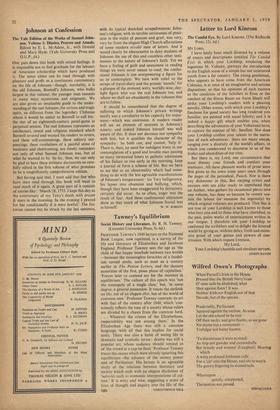Tawney's Equilibrium
Social History and Literature. By R. H. Tawney. (Leicester University Press, 3s. 6d.) Social History and Literature. By R. H. Tawney. (Leicester University Press, 3s. 6d.)
PROFESSOR TAWNEY'S 1949 lecture to the National Book League, now reprinted, is a survey of the life and literature of Elizabethan and Jacobean England. Professor Tawney sees the age as 'the child of that happy interlude between two worlds —between the meaningless ferocities of a feudal- ism turned senile, such as meet us a century earlier in The Pastan Letters, and the demure austerities of the first, pious phase of capitalism.' 'Forces later to contend are for the moment in equilibrium.' The culture of this epoch was 'not the monopoly of a single class,' but, 'in some degree, a general possession. It voices the outlook on life, not of an elegant elite, but of the world of common men.' Professor Tawney contrasts its art with that of the century after 1660, which 'con- sciously reflects the tone of a society whose rulers are divided by a chasm from the common herd. . . . Whatever the crimes of the Elizabethans, respectability was not among them.' In the Elizabethan Age there was still a common language, with all that this implies for social unity. There was also a habit of seeing life in dramatic and symbolic terms : drama was still a popular art, whose audience should remind us of 'the crowd at a cup-tie final.' Professor Tawney traces the causes which were already upsetting this equilibrium—the advance of the money power and of Puritanism. His lecture is an agreeable study of the relations between literature and society which ends with an elegant disclaimer of 'naivetes such as economic interpretations of cul- ture.' It is witty and wise, suggesting a score of lines of thought and inquiry into the life of the










































 Previous page
Previous page